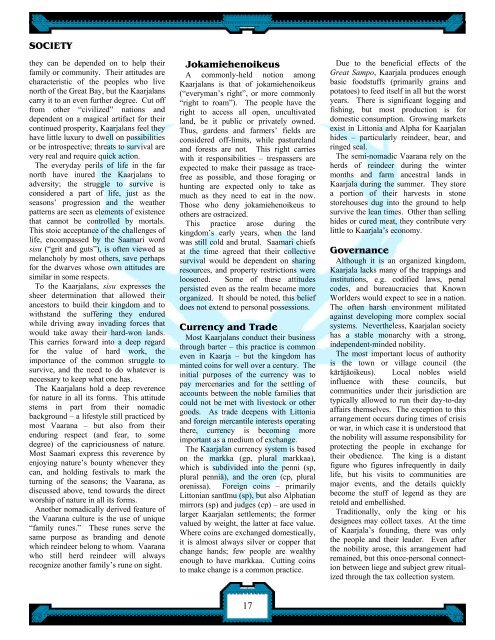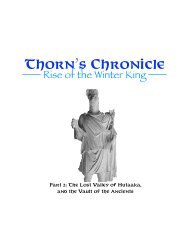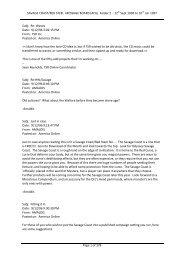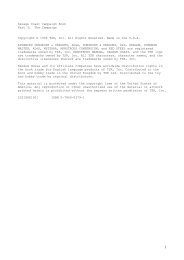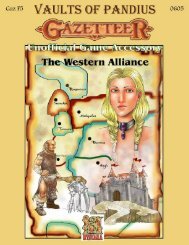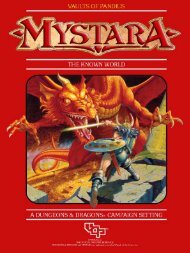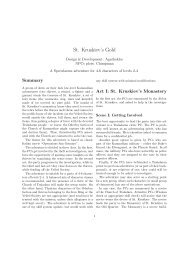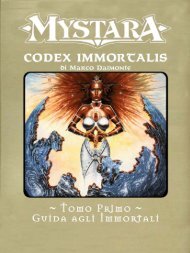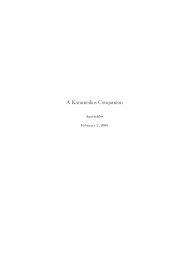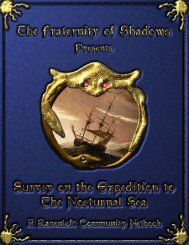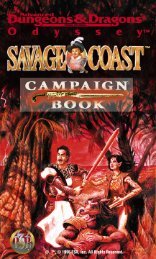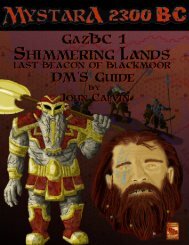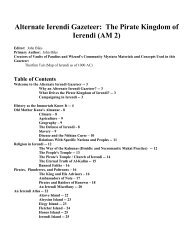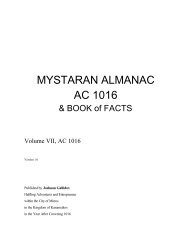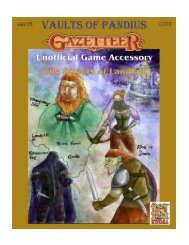Gaz F10 The Kingdom of Kaarjala - Vaults of Pandius
Gaz F10 The Kingdom of Kaarjala - Vaults of Pandius
Gaz F10 The Kingdom of Kaarjala - Vaults of Pandius
Create successful ePaper yourself
Turn your PDF publications into a flip-book with our unique Google optimized e-Paper software.
SOCIETYthey can be depended on to help theirfamily or community. <strong>The</strong>ir attitudes arecharacteristic <strong>of</strong> the peoples who livenorth <strong>of</strong> the Great Bay, but the <strong>Kaarjala</strong>nscarry it to an even further degree. Cut <strong>of</strong>ffrom other “civilized” nations anddependent on a magical artifact for theircontinued prosperity, <strong>Kaarjala</strong>ns feel theyhave little luxury to dwell on possibilitiesor be introspective; threats to survival arevery real and require quick action.<strong>The</strong> everyday perils <strong>of</strong> life in the farnorth have inured the <strong>Kaarjala</strong>ns toadversity; the struggle to survive isconsidered a part <strong>of</strong> life, just as theseasons’ progression and the weatherpatterns are seen as elements <strong>of</strong> existencethat cannot be controlled by mortals.This stoic acceptance <strong>of</strong> the challenges <strong>of</strong>life, encompassed by the Saamari wordsisu (“grit and guts”), is <strong>of</strong>ten viewed asmelancholy by most others, save perhapsfor the dwarves whose own attitudes aresimilar in some respects.To the <strong>Kaarjala</strong>ns, sisu expresses thesheer determination that allowed theirancestors to build their kingdom and towithstand the suffering they enduredwhile driving away invading forces thatwould take away their hard-won lands.This carries forward into a deep regardfor the value <strong>of</strong> hard work, theimportance <strong>of</strong> the common struggle tosurvive, and the need to do whatever isnecessary to keep what one has.<strong>The</strong> <strong>Kaarjala</strong>ns hold a deep reverencefor nature in all its forms. This attitudestems in part from their nomadicbackground – a lifestyle still practiced bymost Vaarana – but also from theirenduring respect (and fear, to somedegree) <strong>of</strong> the capriciousness <strong>of</strong> nature.Most Saamari express this reverence byenjoying nature’s bounty whenever theycan, and holding festivals to mark theturning <strong>of</strong> the seasons; the Vaarana, asdiscussed above, tend towards the directworship <strong>of</strong> nature in all its forms.Another nomadically derived feature <strong>of</strong>the Vaarana culture is the use <strong>of</strong> unique“family runes.” <strong>The</strong>se runes serve thesame purpose as branding and denotewhich reindeer belong to whom. Vaaranawho still herd reindeer will alwaysrecognize another family’s rune on sight.JokamiehenoikeusA commonly-held notion among<strong>Kaarjala</strong>ns is that <strong>of</strong> jokamiehenoikeus(“everyman’s right”, or more commonly“right to roam”). <strong>The</strong> people have theright to access all open, uncultivatedland, be it public or privately owned.Thus, gardens and farmers’ fields areconsidered <strong>of</strong>f-limits, while pasturelandand forests are not. This right carrieswith it responsibilities – trespassers areexpected to make their passage as tracefreeas possible, and those foraging orhunting are expected only to take asmuch as they need to eat in the now.Those who deny jokamiehenoikeus toothers are ostracized.This practice arose during thekingdom’s early years, when the landwas still cold and brutal. Saamari chiefsat the time agreed that their collectivesurvival would be dependent on sharingresources, and property restrictions wereloosened. Some <strong>of</strong> these attitudespersisted even as the realm became moreorganized. It should be noted, this beliefdoes not extend to personal possessions.Currency and TradeMost <strong>Kaarjala</strong>ns conduct their businessthrough barter – this practice is commoneven in Kaarja – but the kingdom hasminted coins for well over a century. <strong>The</strong>initial purposes <strong>of</strong> the currency was topay mercenaries and for the settling <strong>of</strong>accounts between the noble families thatcould not be met with livestock or othergoods. As trade deepens with Littoniaand foreign mercantile interests operatingthere, currency is becoming moreimportant as a medium <strong>of</strong> exchange.<strong>The</strong> <strong>Kaarjala</strong>n currency system is basedon the markka (gp, plural markkaa),which is subdivided into the penni (sp,plural penniä), and the oren (cp, pluralorenissa). Foreign coins – primarilyLittonian santīmu (sp), but also Alphatianmirrors (sp) and judges (cp) – are used inlarger <strong>Kaarjala</strong>n settlements; the formervalued by weight, the latter at face value.Where coins are exchanged domestically,it is almost always silver or copper thatchange hands; few people are wealthyenough to have markkaa. Cutting coinsto make change is a common practice.Due to the beneficial effects <strong>of</strong> theGreat Sampo, <strong>Kaarjala</strong> produces enoughbasic foodstuffs (primarily grains andpotatoes) to feed itself in all but the worstyears. <strong>The</strong>re is significant logging andfishing, but most production is fordomestic consumption. Growing marketsexist in Littonia and Alpha for <strong>Kaarjala</strong>nhides – particularly reindeer, bear, andringed seal.<strong>The</strong> semi-nomadic Vaarana rely on theherds <strong>of</strong> reindeer during the wintermonths and farm ancestral lands in<strong>Kaarjala</strong> during the summer. <strong>The</strong>y storea portion <strong>of</strong> their harvests in stonestorehouses dug into the ground to helpsurvive the lean times. Other than sellinghides or cured meat, they contribute verylittle to <strong>Kaarjala</strong>’s economy.GovernanceAlthough it is an organized kingdom,<strong>Kaarjala</strong> lacks many <strong>of</strong> the trappings andinstitutions, e.g. codified laws, penalcodes, and bureaucracies that KnownWorlders would expect to see in a nation.<strong>The</strong> <strong>of</strong>ten harsh environment militatedagainst developing more complex socialsystems. Nevertheless, <strong>Kaarjala</strong>n societyhas a stable monarchy with a strong,independent-minded nobility.<strong>The</strong> most important locus <strong>of</strong> authorityis the town or village council (thekäräjäoikeus). Local nobles wieldinfluence with these councils, butcommunities under their jurisdiction aretypically allowed to run their day-to-dayaffairs themselves. <strong>The</strong> exception to thisarrangement occurs during times <strong>of</strong> crisisor war, in which case it is understood thatthe nobility will assume responsibility forprotecting the people in exchange fortheir obedience. <strong>The</strong> king is a distantfigure who figures infrequently in dailylife, but his visits to communities aremajor events, and the details quicklybecome the stuff <strong>of</strong> legend as they areretold and embellished.Traditionally, only the king or hisdesignees may collect taxes. At the time<strong>of</strong> <strong>Kaarjala</strong>’s founding, there was onlythe people and their leader. Even afterthe nobility arose, this arrangement hadremained, but this once-personal connectionbetween liege and subject grew ritualizedthrough the tax collection system.17


